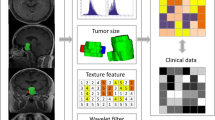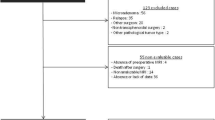Abstract
Objective
Cavernous sinus invasion (CSI) plays a pivotal role in determining management in pituitary adenomas. The study aimed to develop a Convolutional Neural Network (CNN) model to diagnose CSI in multiple centers.
Methods
A total of 729 cases were retrospectively obtained in five medical centers with (n = 543) or without CSI (n = 186) from January 2011 to December 2021. The CNN model was trained using T1-enhanced MRI from two pituitary centers of excellence (n = 647). The other three municipal centers (n = 82) as the external testing set were imported to evaluate the model performance. The area-under-the-receiver-operating-characteristic-curve values (AUC-ROC) analyses were employed to evaluate predicted performance. Gradient-weighted class activation mapping (Grad-CAM) was used to determine models' regions of interest.
Results
The CNN model achieved high diagnostic accuracy (0.89) in identifying CSI in the external testing set, with an AUC-ROC value of 0.92 (95% CI, 0.88–0.97), better than CSI clinical predictor of diameter (AUC-ROC: 0.75), length (AUC-ROC: 0.80), and the three kinds of dichotomizations of the Knosp grading system (AUC-ROC: 0.70–0.82). In cases with Knosp grade 3A (n = 24, CSI rate, 0.35), the accuracy the model accounted for 0.78, with sensitivity and specificity values of 0.72 and 0.78, respectively. According to the Grad-CAM results, the views of the model were confirmed around the sellar region with CSI.
Conclusions
The deep learning model is capable of accurately identifying CSI and satisfactorily able to localize CSI in multicenters.




Similar content being viewed by others
Data availability
The data used to support the findings of this study are available from the corresponding author upon request.
Code availability
No custom-made code or commercially available software code was used.
Abbreviations
- AUC-ROC:
-
The area under the receiver operating characteristic
- CNN:
-
Convolutional Neural Network
- CSI:
-
Cavernous sinus invasion
- DOR:
-
Diagnostic odds ratio
- Grad-CAM:
-
Gradient-weighted class activation mapping
- ICA:
-
Internal carotid artery
- MRI:
-
Magnetic resonance imaging
- NPV:
-
Negative predictive value
- PA:
-
Pituitary adenoma
- PPV:
-
Positive predictive value
- ROI:
-
Regions of interest
References
Anwar SM, Majid M, Qayyum A, Awais M, Alnowami M, Khan MK (2018) Medical image analysis using convolutional neural networks: A review. J Med Syst 42:226. https://doi.org/10.1007/s10916-018-1088-1
Asiri AA, Shaf A, Ali T, Aamir M, Irfan M, Alqahtani S, Mehdar KM, Halawani HT, Alghamdi AH, Alshamrani AFA, Alqhtani SM (2023) Brain tumor detection and classification using fine-tuned CNN with ResNet50 and U-Net model: A study on TCGA-LGG and TCIA dataset for MRI applications. Life (Basel) 13. https://doi.org/10.3390/life13071449
Çinar A, Yildirim M (2020) Detection of tumors on brain MRI images using the hybrid convolutional neural network architecture. Med Hypotheses 139:109684. https://doi.org/10.1016/j.mehy.2020.109684
Dai C, Liang S, Sun B, Kang J (2020) The Progress of immunotherapy in refractory pituitary adenomas and pituitary carcinomas. Front Endocrinol (Lausanne) 11:608422. https://doi.org/10.3389/fendo.2020.608422
Esteva A, Robicquet A, Ramsundar B, Kuleshov V, DePristo M, Chou K, Cui C, Corrado G, Thrun S, Dean J (2019) A guide to deep learning in healthcare. Nat Med 25:24–29. https://doi.org/10.1038/s41591-018-0316-z
Faes L, Wagner SK, Fu DJ, Liu X, Korot E, Ledsam JR, Back T, Chopra R, Pontikos N, Kern C, Moraes G, Schmid MK, Sim D, Balaskas K, Bachmann LM, Denniston AK, Keane PA (2019) Automated deep learning design for medical image classification by health-care professionals with no coding experience: A feasibility study. Lancet Digit Health 1:e232–e242. https://doi.org/10.1016/s2589-7500(19)30108-6
Fang Y, Pei Z, Chen H, Wang R, Feng M, Wei L, Li J, Zhang H, Wang S (2021) Diagnostic value of Knosp grade and modified Knosp grade for cavernous sinus invasion in pituitary adenomas: A systematic review and meta-analysis. Pituitary 24:457–464. https://doi.org/10.1007/s11102-020-01122-3
Fang Y, Wang H, Feng M, Chen H, Zhang W, Wei L, Pei Z, Wang R, Wang S (2022) Application of convolutional neural network in the diagnosis of cavernous sinus invasion in pituitary adenoma. Front Oncol 12:835047. https://doi.org/10.3389/fonc.2022.835047
Fernandez-Miranda JC, Zwagerman NT, Abhinav K, Lieber S, Wang EW, Snyderman CH, Gardner PA (2018) Cavernous sinus compartments from the endoscopic endonasal approach: Anatomical considerations and surgical relevance to adenoma surgery. J Neurosurg 129:430–441. https://doi.org/10.3171/2017.2.Jns162214
Hussein S, Kandel P, Bolan CW, Wallace MB, Bagci U (2019) Lung and pancreatic tumor characterization in the deep learning era: novel supervised and unsupervised learning approaches. IEEE Trans Med Imaging 38:1777–1787. https://doi.org/10.1109/tmi.2019.2894349
Kuenzi BM, Park J, Fong SH, Sanchez KS, Lee J, Kreisberg JF, Ma J, Ideker T (2020) Predicting drug response and synergy using a deep learning model of human cancer cells. Cancer Cell 38:672-684.e676. https://doi.org/10.1016/j.ccell.2020.09.014
Mastorakos P, Taylor DG, Chen CJ, Buell T, Donahue JH, Jane JA (2018) Prediction of cavernous sinus invasion in patients with Cushing's disease by magnetic resonance imaging. J Neurosurg 1–6. https://doi.org/10.3171/2018.2.JNS172704
Molitch ME (2017) Diagnosis and treatment of pituitary adenomas: A review. JAMA 317:516–524. https://doi.org/10.1001/jama.2016.19699
Mooney MA, Hardesty DA, Sheehy JP, Bird CR, Chapple K, White WL, Little AS (2017) Rater reliability of the hardy classification for pituitary adenomas in the magnetic resonance imaging era. J Neurol Surg B Skull Base 78:413–418. https://doi.org/10.1055/s-0037-1603649
Ouyang T, Zhang N, Xie S, Tang B, Li J, Xiao L, Zhang F, Wu B, Zhou D, Li M, Hong T (2021) Outcomes and complications of aggressive resection strategy for pituitary adenomas in Knosp grade 4 with transsphenoidal endoscopy. Front Oncol 11:693063. https://doi.org/10.3389/fonc.2021.693063
Raverot G, Burman P, McCormack A, Heaney A, Petersenn S, Popovic V, Trouillas J, Dekkers OM (2018a) European society of endocrinology clinical practice guidelines for the management of aggressive pituitary tumours and carcinomas. Eur J Endocrinol 178:1–24. https://doi.org/10.1530/eje-17-0796
Raverot G, Burman P, McCormack A, Heaney A, Petersenn S, Popovic V, Trouillas J, Dekkers OM (2018b) European society of endocrinology clinical practice guidelines for the management of aggressive pituitary tumours and carcinomas. Eur J Endocrinol 178:G1-g24. https://doi.org/10.1530/eje-17-0796
Raverot G, Ilie MD, Lasolle H, Amodru V, Trouillas J, Castinetti F, Brue T (2021) Aggressive pituitary tumours and pituitary carcinomas. Nat Rev Endocrinol 17:671–684. https://doi.org/10.1038/s41574-021-00550-w
Sarıgül M, Ozyildirim BM, Avci M (2019) Differential convolutional neural network. Neural Netw 116:279–287. https://doi.org/10.1016/j.neunet.2019.04.025
Trouillas J, Jaffrain-Rea ML, Vasiljevic A, Raverot G, Roncaroli F, Villa C (2020) How to classify the pituitary neuroendocrine tumors (PitNET)s in 2020. Cancers (Basel) 12:514–531. https://doi.org/10.3390/cancers12020514
Wu X, Xie SH, Tang B, Yang YQ, Yang L, Ding H, Bao YY, Lan SH, Zhou L, Hong T (2021) Pituitary adenoma with posterior area invasion of cavernous sinus: Surgical anatomy, approach, and outcomes. Neurosurg Rev 44:2229–2237. https://doi.org/10.1007/s10143-020-01404-1
Acknowledgements
The authors would like to thank all investigators involved in this study, without whom the study would not have been possible
Funding
The present study was funded by the National Key R&D Program of China (2021YFE0114300) and the Fujian Provincial Key Project of Science and Technology Plan (grant no. 2018Y0067).
Author information
Authors and Affiliations
Contributions
YF and HW had full access to all of the data in the study and take responsibility for the integrity of the data and the accuracy of the data analysis. Concept and design: YF, SW, RW. Acquisition, analysis, or interpretation of data: YF, DC, SC, CQ, Zi. Critical revision of the manuscript for important intellectual content: SW, RW, HW, MF, LC. Statistical analysis: YF, HW, LW. Obtain funding: SW, YF. Administrative, technical, and material support: SW, YF, HW, HC, JL, SM. Supervision: SW, RW.
Corresponding authors
Ethics declarations
Conflict of interest
We declare that we have no conflict of interest.
Ethics approval
All procedures performed in the studies involving human participants were in accordance with the ethical standards of the institutional and/or national research committee and with the 1964 Helsinki Declaration and its later amendments or comparable ethical standards.
Consent to participate
The requirement for informed consent was waived due to the retrospective study.
Additional information
Publisher's Note
Springer Nature remains neutral with regard to jurisdictional claims in published maps and institutional affiliations.
Supplementary Information
Below is the link to the electronic supplementary material.
Rights and permissions
Springer Nature or its licensor (e.g. a society or other partner) holds exclusive rights to this article under a publishing agreement with the author(s) or other rightsholder(s); author self-archiving of the accepted manuscript version of this article is solely governed by the terms of such publishing agreement and applicable law.
About this article
Cite this article
Fang, Y., Wang, H., Cao, D. et al. Multi-center application of a convolutional neural network for preoperative detection of cavernous sinus invasion in pituitary adenomas. Neuroradiology 66, 353–360 (2024). https://doi.org/10.1007/s00234-024-03287-1
Received:
Accepted:
Published:
Issue Date:
DOI: https://doi.org/10.1007/s00234-024-03287-1




